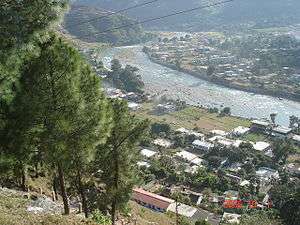Sarju River
| Sarju River | |
|---|---|
|
Sarju River flowing through Bageshwar | |
| Country |
|
| State | Uttarakhand |
| region | Kumaon |
| Basin | |
| Main source |
Kumaon Himalaya, 15 km south of Nanda Kot 3,000 m (9,800 ft) 30°7′58″N 80°1′56″E / 30.13278°N 80.03222°E |
| River mouth |
Sharda River,[1] Uttarakhand, India 420 m (1,380 ft) 29°26′38″N 80°14′33″E / 29.44389°N 80.24250°ECoordinates: 29°26′38″N 80°14′33″E / 29.44389°N 80.24250°E |
| Alt. difference | Approx. 2,580 m (8,460 ft)[2] |
| Physical characteristics | |
| Length | 130 km |
| Features | |
| Tributaries |
|
The Sarju River (also Saryu) is a major river draining Central Kumaon region[3] in the Indian state of Uttarakhand.[4] The Sarju is the largest tributary of the Sharda River.[5][6] The river forms the South-eastern border between the districts of Pithoragarh and Almora.[7][8] Temperate and sub-Tropical forests cover the entire Catchment area of the River.[9]
Course
The Sarju rises in the extreme north of the district Bageshwar on the southern slope of a ridge of the Nanda Kot. It flows initially around 50 km in southwest direction by the Kumaon Himalayas where it receives Punger river from the left and Lahor river from the right.[10] Then the river turns towards south and flows through the city of Bageshwar, where it receives Gomati from the right.[11][12] The Sarju flows to the lower 65 km in mainly southeastern direction.[13] 20 km above its mouth, Ramganga meets the left side on the Sarju. Finally Sarju reaches at Pancheshwar at the Nepalese border to Sharda River after travelling a total of 130 km.
Geology
Sarju transfers a sedimental load of 498.4kg/sec during the peak of raining season.[14]
| Parameter | PH | Alkalinity | Hardness | Conductivity | Calcium | Magnesium | Sodium | Potassium | Chloride | Sulphate |
| Value | 7.9 | 111.2 | 101.32 | 137.11 | 18.89 | 11.11 | 3.50 | 1.80 | 8.10 | 2.41 |
Tributaries
Gomati
Gomati river originates in the higher reaches of Bhatkot and merges into Sarju river at Bageshwar.[17] It flows through the Katyur Valley which constitutes a major Agricultural zone of Kumaon.[18]
Punger
Punger river rises near village Sangar and joins Sarju from the left at Sartana.[19]
Lahor
Lahor is a small river that joins Sarju from the right.[20]
Panar
Panar originates on the northern slopes of the Mornaula Range, south-east of Almora.[21] Panar joins Sarju near Rameshwar.[22]
Ramganga
Ramganga is the largest tributary of Sarju. It originates from the Namik Glacier in Pithoragarh district of Uttarakhand and flows towards Southeast.[23][24] The river is fed by numerous small and big rivers and finally joins river Sarju at Rameshwar.[25]
Notes
- ↑ Sharda River is known as Kali Ganga in mountainous regions of Kumaon
- ↑ The Elevation of source and Elevation of Mouth has been used to find out this estimate
- ↑ Negi, Kumaun: The Land and the People, pg-82
- ↑ Conder, India, pg-238
- ↑ Gulia, Discovering Himalaya: Tourism Of Himalayan Region, pg-84
- ↑ Rawat, Forest Management in Kumaon Himalaya, pg-18
- ↑ Aggarwal, Uttarakhand: Past, Present, and Future, pg-170
- ↑ Aggarwal, Uttarakhand: Past, Present, and Future, pg-331
- ↑ Negi, Himalayan Rivers, Lakes, and Glaciers, pg-120
- ↑ Aggarwal, Uttarakhand: Past, Present, and Future, pg-182
- ↑ Budhawar, The Call of the Mountains: Uttrakhand Explored, pg-39
- ↑ Guneratne, Culture and the Environment in the Himalaya, pg-134
- ↑ Aggarwal, Uttarakhand: Past, Present, and Future, pg-182
- ↑ Bhatt, Ecology of the Mountain Waters, pg-48,49
- ↑ All values in mg/l except ph and conductivity
- ↑ Bhatt, Ecology of the Mountain Waters, pg-97
- ↑ Rawat, Forest Management in Kumaon Himalaya, pg-19
- ↑ Rawat, Forest Management in Kumaon Himalaya, pg-19
- ↑ Aggarwal, Uttarakhand: Past, Present, and Future, pg-183
- ↑ Aggarwal, Uttarakhand: Past, Present, and Future, pg-182
- ↑ Rawat, Forest Management in Kumaon Himalaya, pg-19
- ↑ Rawat, Forest Management in Kumaon Himalaya, pg-19
- ↑ Negi, Himalayan Rivers, Lakes, and Glaciers, pg-115
- ↑ Rawat, Forest Management in Kumaon Himalaya, pg-18
- ↑ Negi, Himalayan Rivers, Lakes, and Glaciers, pg-48
References
- Rawat, Ajay Singh. Forest Management in Kumaon Himalaya: Struggle of the Marginalised People. Indus Publishing. ISBN 9788173871016.
- Gulia, K. S. Discovering Himalaya : Tourism Of Himalayan Region (2 Vols.). Gyan Publishing House. ISBN 9788182054103.
- Negi, Sharad Singh. Kumaun: The Land and the People. Indus Publishing. ISBN 9788185182896.
- Negi, Sharad Singh. Himalayan Rivers, Lakes, and Glaciers. Indus Publishing. ISBN 9788185182612.
- Bhatt, Shanker D.; Pande, Ravindra K. Ecology of the Mountain Waters. APH Publishing. ISBN 9788170243663.
- Conder, Josiah. India. J. Duncan.
- Aggarwal, J. C.; Agrawal, S. P. Uttarakhand: Past, Present, and Future. Concept Publishing Company. ISBN 9788170225720.
- Bhatt, Shanker D.; Pathak, Jugal K. Himalayan environment, water quality of the drainage basins. Shree Almora Book Depot.
- Budhwar, Prem K. The Call of the Mountains: Uttrakhand Explored. Har-Anand Publications. ISBN 9788124115299.
- Guneratne, Arjun. Culture and the Environment in the Himalaya. Routledge. ISBN 9781135192877.
